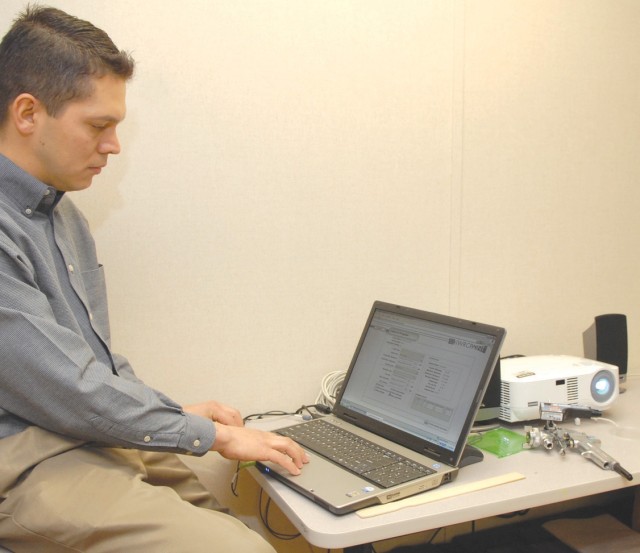TOBYHANNA ARMY DEPOT, Pa. - A new depot painter training program promises to save money and time, improve quality and reduce waste.
The Spray Technique Analysis and Research for Defense (STAR 4D) Program trains personnel in the military refinishing industry. It aids in practice strategies and techniques that enable them to use less material and improve finish quality. Through training, employees learn correct techniques and to reduce waste in the form of paint solids and air emissions.
The STAR 4D program originated from the STAR program, which was developed by the University of Northern Iowa for the automotive refinishing sector. The STAR 4D program is geared toward military coating operations and spray techniques.
The program has been set-up at Air National Guard bases in Iowa, Indiana and Mississippi, and now at the depot.
The Army Environmental Center introduced the STAR 4D program to the Environmental Management Division here. It appealed to division personnel because it seemed like with the training, personnel would use less paint and produce less air emissions, says Matt Ober. He is an environmental engineer in the Industrial Risk Management Directorate's Environmental Management Division.
The program also sparked interest with personnel from the Systems Integration and Support (SIS) Directorate because it would help our painters, adds Ober.
Depot employees from SIS and the Technical Development and Environmental Management divisions attended a "train the trainer" program at thee Iowa Waste Reduction Center.
"We adapted the training to specific paints sprayed at the depot and added a hands-on section which is facilitated by paint experts," says Ober.
Since the initial training, the depot has purchased a Virtual Paint system. The system is a booth that is designed to teach painting techniques. While in the booth, the painter uses a spray gun with laser beams that protrude from the laser guided targeting tool to the target painting surface. The laser beams are adjusted to form a single dot when the spray gun is at the correct distance from the surface. If the gun is too far or too close, the beams will separate. This helps the painter be more consistent.
This system allows painters to train in the new techniques and receive real-time feedback. Also, it doesn't require any paint, which cuts back on the amount of paint we use, says Carmelo Rivera. Rivera is a painter in the SIS's Mobile Equipment Refinishing Branch, and currently working as a trainer in the Business Management Directorate's Technical Development Division.
Part of the training includes learning the four steps of the Chemical Agent Resistant Coating process. These steps aid in the performance of the overall system and include cleaning, pretreating, priming and top coating. It focuses on how to apply paint, the amount of material used, and having control over finish quality.
The training program consists of a four-day class, with about five employees per class. The trainees are given a test on the first day to assess their knowledge prior to any teaching, says Rivera. The instructor uses the test results to decide what areas of the training to focus on.
Next, the trainees are introduced to the Virtual Paint system.
The second day begins with another test. "We were given the same test to evaluate what we learned the day before," says Joseph Limani, a third shift painter in the SIS Directorate's Component Painting Branch. Limani increased his score from 60 percent to 100 percent.
On the third day the students begin their hands-on experience. "We introduce students to the new equipment and refamiliarize them with the old equipment," says Rivera. Before the painters use the Virtual Paint system, they learn a variety of things, such as how to set up paint with the high volume/low pressure paint guns, the proper military specifications and the amount of money that is lost due to improper training.
The fourth day consists of more hands-on experience. The students also learn how to paint camouflage properly. "Hands-on evaluation is performed throughout the class," says Rivera. Students are tested this way so instructors can provide more help with students' painting techniques.
Since October, more than 80 employees out of the 120 painters who currently work in the Refinishing Services Division have received this training. "Our goal is to have 100 percent of the painters trained" says Rivera. He also says that they would like each new painter to go through the STAR 4D program within the first few months of being hired.
Although there are no hard numbers that project potential savings in waste reduction, quality data has been tracked as part of a Black
Belt project in the Productivity Improvement and Innovation Directorate that shows a reduction of paint related rejects, says Mike Romanczuk, Refinishing Services Division chief.
"The program is helping." says Stephen Berryman. "I've noticed that people who went through the training have improved their skills." Berryman is a third shift paint leader in the Component Paint Branch.
Berryman believes there are many advantages to participating in the STAR 4D program. "The Virtual Paint system allows us to practice our skills," he says. "Because of the small class size, there was more opportunity for the instructor to provide individual help." He believes that with this specialized training, painters will perform their job more efficiently.
Berryman, Limani and Rivera all agree that the most beneficial part of the program is that employees can ensure that the Soldier is going to receive a better quality piece of equipment. "The quality of work increases with this program because personnel know they are producing a product that meets current standards," adds Rivera.




Social Sharing